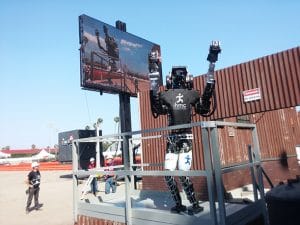DARPA Robotics Challenge

DARPA, a government agency known for innovative advances in technology, sponsored the Robotics Challenge to promote critical improvements in robotics technology for disaster relief operations—especially where severe risks make human action too risky, or time constraints are critical. For example, an accident at a nuclear power plant that involves high levels of radiation might prove too dangerous for humans, but requires quick response.
While DARPA required that the emergency response robots “must be compatible with human operators, environments and tools,” it did not require humanoid form. But the IHMC focus on humanoid robots is rooted in a simple concept: Because the robots will be working in environments built for humans, a human-like robot is best-suited to the challenges involved.
A robot responding to a typical disaster scenario is likely to face rubble and other obstacles, unsettled ground, closed or stuck doors and windows, ladders and other challenges. Humanoid robots that can navigate human-scale environments and use human-type tools will have an advantage. Obviously, sending robots into dangerous situations obviates risk to humans.
Moreover, teaming them with human partners in a system that optimizes their complementary strengths can enhance their performance. For instance, a human at a remote monitoring post, surveying the scene through the robot’s “eyes,” might be called on to make rapid judgments a robot is poor at, such as quickly determining the best path through a debris field. The robot, equipped with precise scanning tools, can quickly provide precise measurements of distance or size in situations where humans could only make rough estimates.
The challenges addressed during the DRC were truly “DARPA Hard” – extremely high in technical risk, but equally high in operational payoff. As a result, this project addressed several unsolved problems in collaborative design of human-machine interfaces, humanoid balance and walking algorithms, humanoid motion planning in complex 3D environments, and combined humanoid mobility and human-machine team manipulation.
IHMC Robotics came in first place at the Virtual Robotics Challenge, second place at the DARPA Robotics Challenge Trials in Homestead, Florida, and second place at the DARPA Robotics Challenge Finals in Pomona, California.
Virtual Robotics Challenge Data
Videos of our VRC runs are found here.
Images and descriptions of our runs are found here.
For any other developers/researchers interested, you can find the Gazebo logs for our official VRC runs here.
Research Projects:
- Humanoid Robots as Human Avatars
- Nadia Humanoid
- Exoskeleton for Improving Mobility
- Cybathlon 2020
- Quadrupedal Locomotion
- Open Source Initiative
Past Projects:
- DARPA Robotics Challenge
- M2V2 Humanoid
- Learning Locomotion
- X1 Mina Exoskeleton
- Cybathlon 2016
- The Grasshopper
- FastRunner
IHMC Research Team:
- Jerry Pratt, Research Scientist, IHMC Team Leader
- Matt Johnson, Research Scientist, IHMC Team Leader
- Peter Neuhaus, Research Scientist
- Sylvain Bertrand, Research Associate
- Duncan Calvert, Research Associate
- John Carff, Research Associate
- Tomas de Boer, Research Associate
- Daniel Duran, Research Associate
- Nicolas Eyssette, Research Associate
- Twan Koolen, Research Associate
- Brooke Layton, Project Coordinator
- Nathan Mertins, Research Associate
- Will Rifenburgh, Research Associate
- Brandon Shrewsbury, Research Associate
- Jesper Smith, Research Associate
- Doug Stephen, Research Associate
- Tingfan Wu, Research Associate
- Peter Abeles
- Sami Alshiekh
- Luca Colasanto
- Travis Craig
- Matthijs Damen
- Jeff van Egmond
- Johannes Englsberger
- Davide Faconti
- Peter Fankhauser
- Luca Fiorio
- Marshall Floyd
- Alex Graber-Tilton
- Maarten Griffieon
- Khai-Long Ho Hoang
- Igor Kalkov
- Pushyami Kaveti
- Justin Kirschbaum
- Jordan Lack
- Alex Lesman
- Nolan Manor
- Stephen McCrory
- Tobias Meier
- Eric Morphis
- Samantha Kobus Munoz
- Brett Rowberry
- Wessel Straatman
- Gray Thomas
- Riewert van Doesburgh
- Georg Wiedebach

